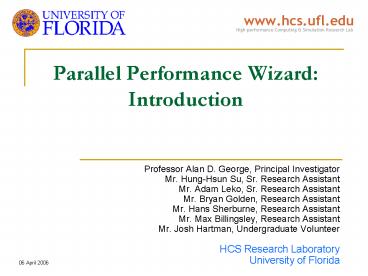Parallel Performance Wizard: Introduction - PowerPoint PPT Presentation
1 / 13
Title:
Parallel Performance Wizard: Introduction
Description:
Discouraging for users, new & old; few options for shared-memory computing in ... Could also be used in conjunction with experimental performance measurement ... – PowerPoint PPT presentation
Number of Views:26
Avg rating:3.0/5.0
Title: Parallel Performance Wizard: Introduction
1
Parallel Performance WizardIntroduction
- Professor Alan D. George, Principal Investigator
- Mr. Hung-Hsun Su, Sr. Research Assistant
- Mr. Adam Leko, Sr. Research Assistant
- Mr. Bryan Golden, Research Assistant
- Mr. Hans Sherburne, Research Assistant
- Mr. Max Billingsley, Research Assistant
- Mr. Josh Hartman, Undergraduate Volunteer
- HCS Research Laboratory
- University of Florida
2
Outline
- Motivations and Objectives
- Background
- Framework Key Features
- Phase II Tasks Schedules
- Todays Schedule
3
Motivations and Objectives
- Motivations
- UPC/SHMEM program does not yield the expected
performance. Why? - Due to complexity of parallel computing,
difficult to determine without tools for
performance analysis and optimization - Discouraging for users, new old few options
for shared-memory computing in UPC and SHMEM
communities - Objectives
- Research topics relating to performance analysis
- Develop framework for a performance analysis tool
- Design with both performance and user
productivity in mind - Develop a performance analysis tool for UPC and
SHMEM
4
Need for Performance Analysis
- Performance analysis of sequential applications
can be challenging - Performance analysis of explicitly communicating
parallel applications is significantly more
difficult - Mainly due to increase in number of processing
nodes - Performance analysis of Implicitly communicating
parallel applications is even more difficult - Non-blocking, one-sided communication is tricky
to track and analyze accurately
5
Background - SHMEM
- SHared MEMory library
- Based on SPMD model
- Available for C / Fortran
- Available for servers and clusters
- Easier to program than MPI
- Hybrid programming model
- Traits of message passing
- Explicit communication, replication and
synchronization - Need to give remote data location (processing
element ID) - Traits of shared memory
- Provides logically shared memory system view
- Non-blocking, one-sided communication
- Lower latency, higher bandwidth communication
- PSHMEM available for some implementations
6
Background - UPC
- Unified Parallel C (UPC)
- Partitioned GAS parallel programming language
- Common and familiar syntax and semantics for
parallel C with simple extensions to ANSI C - Many implementations
- Open source Berkeley UPC, Michigan UPC, GCC-UPC
- Proprietary HP-UPC, Cray-UPC
- Easier to program than MPI, software more
scalable - With hand-tuning, UPC performance compares
favorably with MPI
7
Background Performance Analysis
- Three general performance analysis approaches
- Analytical modeling
- Mostly predictive methods
- Could also be used in conjunction with
experimental performance measurement - Pros easy to use, fast, can be performed without
running the program - Cons usually not very accurate
- Simulation
- Pros allow performance estimation of program
with various system architectures - Cons slow, not generally applicable for regular
UPC/SHMEM users - Experimental performance measurement
- Strategy used by most modern performance analysis
tools (PATs) - Uses actual event measurement to perform analysis
- Pros most accurate
- Cons can be time-consuming
PAT Performance Analysis Tool
8
Background - Experimental Performance Measurement
Stages
- Instrumentation user-assisted or automatic
insertion of instrumentation code - Measurement actual measuring stage
- Analysis data analysis toward bottleneck
detection resolution - Presentation display of analyzed data to user,
deals directly with user - Optimization process of finding and resolving
bottlenecks
9
Framework
10
Key Features
- Semi-automatic source-level instrumentation as
default - Only P module and part of I module are visible to
user - PAPI will be used
- Tracing mode as default with profiling support
- Post-mortem data processing and analysis
- Analyses load balancing, scalability, memory
system - Visualizations timeline display, speedup chart,
call-tree graph, communication volume graph,
memory access graph, profiling table
11
Tasks Schedule
12
Discussion Topic Target Platforms
- Our current platform list changes needed?
- Open
- Quadrics SHMEM on Opterons RHEL4 (qsnet)
- Berkeley UPC on Opterons RHEL4 (iba)
- Proprietary
- Cray UPC on X1E (src. inst)
- Cray SHMEM on X1E
13
Todays Schedule
- 0900 0930 AM Project overview
- 0930 1015 AM Instrumentation (I) module
presentation - 1015 1030 AM BREAK
- 1030 1115 AM Measurement (M) module
presentation - 1115 1145 AM IM-modules demo
- 1145 1300 PM LUNCH
- 1300 1345 PM Analysis (A) module
presentation - 1345 1400 PM A-module demo
- 1400 1445 PM Presentation (P) module
presentation - 1445 1500 PM P-module demo
- 1500 1515 PM BREAK
- 1515 1600 PM Wrap-up planning discussion































